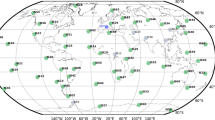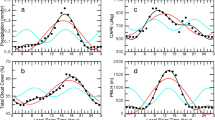Abstract
The differences between the refraction angles measured and calculated for the reanalyses of the European Centre for Medium-Range Weather Forecasts were statistically analyzed on the basis of 64 radio occultation events recorded by the Microlab-1 satellite. It is shown that, for minimum ray heights below 20 km, the main contribution to the differences is made by spatial refractive-index fluctuations neglected by the model. The power spectral density of these fluctuations is mainly concentrated within the vertical wave-number range 0.5–10 rad/km. For heights above 30 km, the deviations are mainly determined by ionospheric disturbances and may vary several times during changes of the site and time of observations. This suggests that the results of satellite radio-occultation sounding of the neutral atmosphere can be used as an indirect quantitative estimate of local discrepancies between the actual field of the refractive index and its values calculated on the basis of a hydrodynamic atmospheric general circulation model.
Similar content being viewed by others
References
R. Ware, M. Exner, D. Feng, et al., “GPS Sounding of the Atmosphere from Low Earth Orbit: Preliminary Results,” Bull. Am. Meteorol. Soc. 77, 10–40 (1996).
E. R. Kursinski, G. A. Hajj, S. S. Leroy, and B. Herman, “The GPS Radio Occultation Technique,” Terr. Atmos. Ocean. Sci. 11, 53–114 (2000).
C. Rocken, R. Anthes, M. Exner, et al., “Analysis and Validation of GPS/MET Data in the Neutral Atmosphere,” J. Geophys. Res. D 102, 29 849–29 866 (1997).
K. Steiner, G. Kirchengast, and H. P. Lasreiter, “Inversion, Error Analysis, and Validation of GPS/MET Data,” Ann. Geophys. 17, 122–138 (1999).
M. E. Gorbunov and L. Kornblueh, “Analysis and Validation of GPS/MET Radio Occultation Data,” J. Geophys. Res. D 106, 17-161–17-169 (2001).
J. Wickert, C. Reigber, and G. Beyerle, “Atmosphere Sounding by GPS Radio Occultation: First Results from CHAMP,” Geophys. Rev. Lett. 28, 3263–3266 (2001).
M. E. Gorbunov and L. Kornblueh, “Analysis and Validation of Challenging Minisatellite Payload (CHAMP) Radio Occultation Data,” J. Geophys. Res. D 108, 4584, doi: 10.1029/2002JD003175 (2003).
M. E. Gorbunov, K. V. Lauritsen, A. Rodin, et al., “Analysis of the CHAMP Experimental Data on Radio-Occultation Sounding of the Earth’s Atmosphere,” Izv. Akad. Nauk, Fiz. Atmos. Okeana 41, 798–813 (2005) [Izv., Atmos. Ocean. Phys. 41, 726–740 (2005)].
V. V. Vorob’ev and T. G. Krasil’nikova, “Estimating the Accuracy of Retrieving the Atmospheric Refractive Index from Measurements of the Doppler Shift at the NAVSTAR Frequencies,” 29, 626–632 (1993).
S. Syndergaard, “On the Ionospheric Calibration in GPS Radio Occultation Measurements,” Radio Sci. 35, 865–883 (2000).
M. E. Gorbunov, “Ionospheric Correction and Statistical Optimization of Radio Occultation Data,” Radio Sci. 37, 17-1–17-9, doi: 10.1029/2000RS002370 (2002).
V. V. Vorob’ev and V. Kan, “Background Fluctuations in the Ionosphere during GPS-Microlab-1 Radio-Occultation Experiment,” Izv. Vyssh. Uchebn. Zaved., Radiofiz. 42, 511–523 (1999).
S. M. Uppala, P. W. Kallberg, A. J. Simmons, et al., “The ERA-40 Re-Analysis,” Q. J. R. Meteorol. Soc., No. 131, 2961–3012, doi: 10.1256/qj.04.176 (2005).
M. E. Gorbunov, “Canonical Transform Method for Processing GPS Radio Occultation Data in Lower Troposphere,” Radio Sci. 37, 9-1–9-10, doi:10.1029/2000RS002592 (2002).
M. E. Gorbunov and K. B. Lauritsen, “Canonical Transform Methods for Radio Occultation Data,” Scientific Report No. 02-10 (Danish Meteorological Institute, Copenhagen, 2002); http://www.dmi.dk/dmi/Sr02-10.pdf.
A. S. Jensen, M. S. Lohmann, H.-H. Benzon, and A. S. Nielsen, “Full Spectrum Inversion of Radio Occultation Signals,” Radio Sci. 38, 6-1–6-15, doi:10.1029/2002RS002763 (2003).
M. E. Gorbunov, H.-H. Benzon, A. S. Jensen, et al., “Comparative Analysis of Radio Occultation Processing Approaches Based on Fourier Integral Operators,” Radio Sci. 39, 6004, doi: 10.1029/2003RS002916 (2004).
A. S. Jensen, M. S. Lohmann, A. S. Nielsen, and H.-H. Benzon, “Geometrical Optics Phase Matching of Radio Occultation Signals,” Radio Sci. 39, 3009, doi: 10.1029/2003RS002899 (2004).
M. E. Gorbunov and K. B. Lauritsen, “Analysis of Wave Fields by Fourier Integral Operators and Its Application for Radio Occultations,” Radio Sci. 39, 4010, doi: 10.1029/2003RS002971 (2004).
M. E. Gorbunov, “Analysis of the Data of Radio-Occultation Sounding of the Earth’s Atmosphere with the Use of the Theory of Fourier Integral Operators,” Elektromagn. Volny Elektron. Sist., No. 9, 9–10 (2004).
A. M. Yaglom, Correlation Theory of Stationary Random Functions (Gidrometeoizdat, Leningrad, 1981) [in Russian].
J. S. Bendat and A. G. Piersol, Engineering Applications of Correlation and Spectral Analysis (Mir, Moscow, 1983; Wiley, New York, 1980).
Author information
Authors and Affiliations
Additional information
Original Russian Text © A.S. Gurvich, M.E. Gorbunov, L. Kornblueh, 2006, published in Izvestiya AN. Fizika Atmosfery i Okeana, 2006, Vol. 42, No. 6, pp. 771–777.
Rights and permissions
About this article
Cite this article
Gurvich, A.S., Gorbunov, M.E. & Kornblueh, L. Comparison between refraction angles measured in the Microlab-1 experiment and calculated on the basis of an atmospheric general circulation model. Izv. Atmos. Ocean. Phys. 42, 709–714 (2006). https://doi.org/10.1134/S0001433806060053
Received:
Accepted:
Issue Date:
DOI: https://doi.org/10.1134/S0001433806060053




